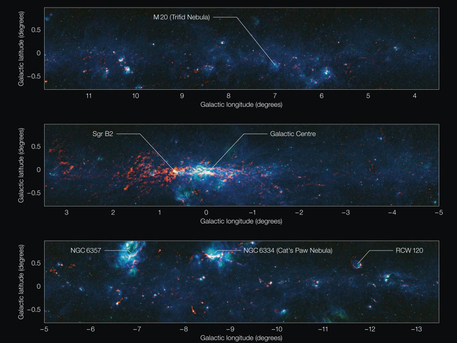Astronomer's new guide to the galaxy
Largest map of cold dust revealed
 © ESO/APEX & MSX/IPAC/NASA |
You can see the Trifid Nebula, a nebula containing an open cluster of stars as well as a stellar nursery. The name “Trifid” refers to the way that dense dust appears to divide it into three lobes at visible wavelengths. You can also see the center of the Milky Way, home to a supermassive black hole more than four million times the mass of our Sun. It is about 25 000 light-years from Earth.
“ATLASGAL gives us a new look at the Milky Way. Not only will it help us investigate how massive stars form, but it will also give us an overview of the larger-scale structure of our galaxy”, said Frederic Schuller from the Max Planck Institute for Radio Astronomy, leader of the ATLASGAL team.
The Universe is relatively unexplored at submillimeter wavelengths, as extremely dry atmospheric conditions and advanced detector technology are required for such observations.
The interstellar medium — the material between the stars — is composed of gas and grains of cosmic dust, rather like fine sand or soot. However, the gas is mostly hydrogen and relatively difficult to detect, so astronomers often search for these dense regions by looking for the faint heat glow of the cosmic dust grains.
Submillimeter light allows astronomers to see these dust clouds shining, even though they obscure our view of the Universe at visible light wavelengths. Accordingly, the ATLASGAL map includes the denser central regions of our galaxy, in the direction of the constellation of Sagittarius — home to a supermassive black hole — that are otherwise hidden behind a dark shroud of dust clouds.
The newly released map also reveals thousands of dense dust clumps, many never seen before, which mark the future birthplaces of massive stars. The clumps are typically a couple of light-years in size, and have masses of between ten and a few thousand times the mass of our Sun. In addition, ATLASGAL has captured images of beautiful filamentary structures and bubbles in the interstellar medium, blown by supernovae and the winds of bright stars.
ESO
Astronomer's new guide to the galaxy
Largest map of cold dust revealed
 © ESO/APEX & MSX/IPAC/NASA |
You can see the Trifid Nebula, a nebula containing an open cluster of stars as well as a stellar nursery. The name “Trifid” refers to the way that dense dust appears to divide it into three lobes at visible wavelengths. You can also see the center of the Milky Way, home to a supermassive black hole more than four million times the mass of our Sun. It is about 25 000 light-years from Earth.
“ATLASGAL gives us a new look at the Milky Way. Not only will it help us investigate how massive stars form, but it will also give us an overview of the larger-scale structure of our galaxy”, said Frederic Schuller from the Max Planck Institute for Radio Astronomy, leader of the ATLASGAL team.
The Universe is relatively unexplored at submillimeter wavelengths, as extremely dry atmospheric conditions and advanced detector technology are required for such observations.
The interstellar medium — the material between the stars — is composed of gas and grains of cosmic dust, rather like fine sand or soot. However, the gas is mostly hydrogen and relatively difficult to detect, so astronomers often search for these dense regions by looking for the faint heat glow of the cosmic dust grains.
Submillimeter light allows astronomers to see these dust clouds shining, even though they obscure our view of the Universe at visible light wavelengths. Accordingly, the ATLASGAL map includes the denser central regions of our galaxy, in the direction of the constellation of Sagittarius — home to a supermassive black hole — that are otherwise hidden behind a dark shroud of dust clouds.
The newly released map also reveals thousands of dense dust clumps, many never seen before, which mark the future birthplaces of massive stars. The clumps are typically a couple of light-years in size, and have masses of between ten and a few thousand times the mass of our Sun. In addition, ATLASGAL has captured images of beautiful filamentary structures and bubbles in the interstellar medium, blown by supernovae and the winds of bright stars.
ESO





